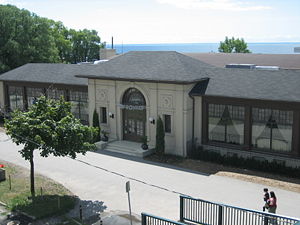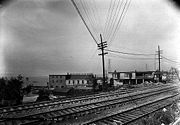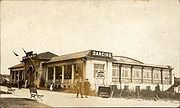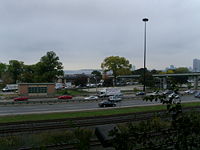
Palais Royale
Encyclopedia

- For the palace in Paris see Palais-Royal, for the future skyscraper in Mumbai see Palais Royale, Mumbai.
Palais Royale is a dance hall in Toronto
Toronto
Toronto is the provincial capital of Ontario and the largest city in Canada. It is located in Southern Ontario on the northwestern shore of Lake Ontario. A relatively modern city, Toronto's history dates back to the late-18th century, when its land was first purchased by the British monarchy from...
, Ontario
Ontario
Ontario is a province of Canada, located in east-central Canada. It is Canada's most populous province and second largest in total area. It is home to the nation's most populous city, Toronto, and the nation's capital, Ottawa....
, Canada
Canada
Canada is a North American country consisting of ten provinces and three territories. Located in the northern part of the continent, it extends from the Atlantic Ocean in the east to the Pacific Ocean in the west, and northward into the Arctic Ocean...
, located on Lake Shore Boulevard at the foot of Roncesvalles Avenue
Roncesvalles Avenue
Roncesvalles Avenue is a north-south arterial street in Toronto, Canada. It connects Queen Street West, King Street West and runs north to Dundas Street West. Roncesvalles Avenue takes its name from the Battle of Roncesvalles, which took place in the Roncesvalles gorge in Spain in 1813...
on Lake Ontario
Lake Ontario
Lake Ontario is one of the five Great Lakes of North America. It is bounded on the north and southwest by the Canadian province of Ontario, and on the south by the American state of New York. Ontario, Canada's most populous province, was named for the lake. In the Wyandot language, ontarío means...
. Originally built as a boat works, it became notable as a night club in the now-defunct Sunnyside Amusement Park
Sunnyside Amusement Park
Sunnyside is a lakefront district in Toronto, Ontario, Canada. It includes a beach and park area along Lake Ontario's Humber Bay, to the west of the Exhibition grounds, at the foot of Roncesvalles Avenue where it meets King Street West and Queen Street West. In the 1910s, the area was the site of a...
, hosting many prominent 'big band' jazz bands. Since the Park's demolition, the building has ceased to be a nightclub, being used for special occasions and concerts. It has recently been remodeled and is in use for special occasions and meetings.
History

High Park
High Park is a municipal park in Toronto, Ontario, Canada. It spans , and is a mixed recreational and natural park, with sporting facilities, cultural facilities, educational facilities, gardens, playgrounds and a zoo. One third of the park remains in a natural state, with a rare oak savannah ecology...
. Starting in the 1910s, the waterfront was redeveloped by the Toronto Harbour Commission
Toronto Harbour Commission
The Toronto Harbour Commission was a joint federal-municipal government agency based in Toronto, Ontario, Canada. The agency managed Toronto Harbour as well as being responsible for major works along the Toronto waterfront. It built the Toronto Island Airport in 1939...
and all of the waterfront buildings were removed. The waterfront was extended to the south and new buildings were constructed to replace those removed.
The new Dean’s Sunnyside Pleasure Boats, a canoe boat-building factory and a supplier to the local Parkdale canoe club was opened in 1922 as part of the new Sunnyside Beach. The new building was designed by the architectural firm of Chapman, Oxley & Bishop
Chapman and Oxley
Chapman and Oxley was a Toronto, Ontario, Canada - based architectural firm and responsible for designing a number of Beaux Arts buildings in the city in the 1920s and 1930s...
, architects who designed the Sunnyside Bathing Pavilion
Sunnyside Bathing Pavilion
Sunnyside Bathing Pavilion is a landmark public pavilion in the Sunnyside lakefront area of Toronto, Ontario, Canada. Built in 1922, its original function was to provide changing facilities for swimming in Lake Ontario, however lake conditions were often too cold and an adjoining public swimming...
, which opened that same year nearby. The boat-building activities occupied the basement and part of the first floor, which was at shoreline level. The second floor, at ground level from the front, became a dance hall. Although Dean’s Pleasure Boats was successful for some time, it eventually went out of business and the Palais became a dance hall only.

Duke Ellington
Edward Kennedy "Duke" Ellington was an American composer, pianist, and big band leader. Ellington wrote over 1,000 compositions...
and Count Basie
Count Basie
William "Count" Basie was an American jazz pianist, organist, bandleader, and composer. Basie led his jazz orchestra almost continuously for nearly 50 years...
, Paul Whiteman
Paul Whiteman
Paul Samuel Whiteman was an American bandleader and orchestral director.Leader of the most popular dance bands in the United States during the 1920s, Whiteman's recordings were immensely successful, and press notices often referred to him as the "King of Jazz"...
and the Dorsey Brothers played there. The largest audience was in 1933, when 3000 people danced to Eddie Duchin's Park Central Orchestra from New York. From 1933 to 1950, Bert Niosi
Bert Niosi
Bert Niosi was a Canadian bandleader, known as "Canada's King of Swing".-Biography:...
"Canada's King of Swing" and his orchestra were the house band.
Admission was 10 cents plus five cents a dance. Only soft drinks were available and certain dances, such as the jitterbug, were forbidden as they were considered too risqué. Dances were held six nights a week (dancing was not allowed on Sundays).
The land on which the Palais Royale was built was originally leased from the Toronto Harbour Commission in 1922 for 21 years. Cuthbert and Deller renewed the lease in 1944 for another 21 years.. They sold their rights to Joe Broderick in 1949. Broderick operated the facility as a dance hall from 1949 to 1966.
1955–present: After the Amusement Park
In 1955, Sunnyside Amusement Park was demolished for the Gardiner ExpresswayGardiner Expressway
The Frederick G. Gardiner Expressway, colloquially referred to as "the Gardiner", is a municipal expressway in the Canadian province of Ontario, connecting downtown Toronto with its western suburbs...
and Lake Shore Boulevard expansions. In the period 1956-1959 the hall lost money, but Broderick was showing profits again by 1964.. Broderick attempted to negotiate a further lease in 1965 but he was not successful and he sold his rights to the Polish National Union in January 1966. By this time the land had been transferred to the City of Toronto, which had placed the Palais Royale on its list of properties for demolition in 1965. It was then that the City removed the hall's east-side parking lot, formerly the mini-golf course, planting grass and willow trees. However, instead of being demolished, the property was instead designated as a historic site by the City in 1974.
Since then, the hall has been used for concerts by a diverse range of musicians. From Stan Kenton, Woody Herman, The Carlton Show Band, The Specials, Joe Jackson and Rough Trade around 1980 to concerts by Blur
Blur (band)
Blur is an English alternative rock band. Formed in London in 1989 as Seymour, the group consists of singer Damon Albarn, guitarist Graham Coxon, bassist Alex James and drummer Dave Rowntree. Blur's debut album Leisure incorporated the sounds of Madchester and shoegazing...
, Blue Rodeo
Blue Rodeo
Blue Rodeo is a Canadian pop and country rock band, which was formed in 1984 in Toronto, Ontario. They have been signed with Warner Music Group since their debut album Outskirts in March 1987...
, Sigur Rós
Sigur Rós
Sigur Rós is an Icelandic post-rock band with classicaland minimalist elements. The band is known for its ethereal sound, and frontman Jónsi Birgisson's falsetto vocals and use of bowed guitar. In January 2010, the band announced that they will be on hiatus. Since then, it has since been announced...
, Echo & the Bunnymen
Echo & the Bunnymen
Echo & the Bunnymen are an English post-punk band, formed in Liverpool in 1978. The original line-up consisted of vocalist Ian McCulloch, guitarist Will Sergeant and bass player Les Pattinson, supplemented by a drum machine. By 1980, Pete de Freitas had joined as the band's drummer, and their debut...
, The Sadies
The Sadies
The Sadies are a Canadian indie rock and alternative country band from Toronto, Ontario.-Background:The band consists of Dallas Good , Travis Good, Sean Dean and Mike Belitsky...
, Constantines
Constantines
-History:The band was formed by Steve Lambke, Bryan Webb, Doug MacGregor, and Dallas Wehrle in 1999, following the break-up of Webb and MacGregor's emotional hardcore band Shoulder...
, Sloan
Sloan (band)
Sloan is a Toronto-based alternative rock quartet from Halifax, Nova Scotia. Throughout their 20-year tenure Sloan has released 10 LPs , two EPs, a live album, a "best of" collection and no less than thirty singles...
and a The Rolling Stones
The Rolling Stones
The Rolling Stones are an English rock band, formed in London in April 1962 by Brian Jones , Ian Stewart , Mick Jagger , and Keith Richards . Bassist Bill Wyman and drummer Charlie Watts completed the early line-up...
concert on August 16, 2002. The building was a film location for the 1990 film "Queen of Mean".
On June 18 1986, the City of Toronto attempted to buy out the lease for the Palais Royale for $82,500, the price at which the property was valued in 1922. The Polish National Union claimed it had spent $236,697 on repairs to the building and refused the offer. In June 1987, the City began legal action to retain control of the property, a process which ended with a decision by the Ontario Court of Appeal on March 28, 1994 which terminated the lease on April 16, 1999.
The Property was leased to Shoreline Entertainment in 2000, on the condition that repairs and renovations be made to the hall. Shoreline transferred the lease to the Pegasus Group in 2005. The Group spent $3.5 million on renovations, gutting the interior, replacing the windows and rebuilding the rear terrace. Described by Den Farnworth of Goldsmith Borgal Architects as "it's not a true restoration, it's more an adaptive reuse
Adaptive reuse
Adaptive reuse refers to the process of reusing an old site or building for a purpose other than which it was built or designed for. Along with brownfield reclamation, adaptive reuse is seen by many as a key factor in land conservation and the reduction of urban sprawl...
", the renovations attracted some controversy.
In September 2006, the Palais Royale hosted its official Grand Re-Opening, and the house band for the evening was the stellar Toronto All-Star Big Band, composed of young performers from around Ontario. This band is reminiscent of the Goodman, Miller, and Shaw era of swinging dance tunes and is fronted by one of Toronto's finest vocal groups, the TABB-5.
Controversies

Anachronism
An anachronism—from the Greek ανά and χρόνος — is an inconsistency in some chronological arrangement, especially a chronological misplacing of persons, events, objects, or customs in regard to each other...
on a building of the Art Deco
Art Deco
Art deco , or deco, is an eclectic artistic and design style that began in Paris in the 1920s and flourished internationally throughout the 1930s, into the World War II era. The style influenced all areas of design, including architecture and interior design, industrial design, fashion and...
era. Supporters tout the security of its contemporized design, one more likely to attract paying customers and ensure future maintenance, and ultimately, the existence of the structure.
In addition to the design controversy, a controversy erupted over the restoration of the facility's parking lot, which was removed in 1965 and replaced by grass and willow trees, which had grown to mature height in the meantime. Local groups opposed the removal of the trees to repave the parking lot and opposed paving a new parking lot, proposing on-street parking. After public consultations, the City of Toronto has since paved a new parking lot for the hall across the street on former Amusement Park lands between the east and west lanes of Lake Shore Boulevard, and provided a set of stoplights for customers to cross the street to the hall, but preserving the willow trees of the old lot.
Redevelopment plans for the waterfront area include the relocation of Lake Shore Boulevard and the parking lots north, against the Gardiner right-of-way, freeing up park lands along the water.

